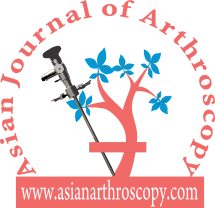Volume 5 | Issue 2 | September-December 2020 | Page 02-06 | Divya Bandari, David V. Rajan, Santosh Sahanand
Author: Divya Bandari [1], David V. Rajan[1], Santosh Sahanand [1]
[1] Department of Orthopaedics, Gandhi Medical College/Hospital, Musheerabad, Hyderabad, Telangana, India.
[2] Ortho-One Orthopaedic Speciality centre, Hyderabad, Telangana, India.
Address of Correspondence:
Dr. Divya Bandari,
Assistant Proffesor, Gandhi Medical College/Hospital 1-6-129 , Opp. kausalya nivas , near Bharat seva samaj
Musheerabad, Hyderabad, Telangana, India. 500020
E-mail: divi.bandari15@gmail.com
Abstract
Introduction: A BPTB graft is the preferred choice of graft fixation, especially for young athletes who are involved in contact sports. However, there have been limited studies to determine and quantify the degree and characteristics of anterior knee pain and differentiate it from kneeling pain as a separate entity.
Study type: Prospective Study
Materials and methods: In our study we have followed 60 patients 30 each of BPTB and STG graft ACL reconstruction from 2013 to 2016 visiting Ortho one orthopaedic speciality centre with a minimum follow up period of 2 years and assessed the anterior knee pain and kneeling pain in terms of difficulty with the help of IKDC score and also quantified them with the help of VAS scores. We divided Anterior knee pain and Kneeling pain into no pain(VAS 0), mild pain (VAS 1-3), moderate pain(VAS 4-7) and severe pain (VAS 8-10).
Results: On quantifying the pain using the VAS score for anterior knee pain the BPTB and STG group showed no patients with severe pain (8 to 10) at the end of 12 and 24 months. Moderate pain (4 to 7) at 12 months was seen in 12 patients each (40%) and at 24 months in 5 patients (15%) in BPTB group and 4 patients (13.3%) in STG group. There was statistically no diff between both groups at 1 and 2 years follow up. (>0.05)Our study showed less incidence and severity than previously published studies.
Conclusion: The results of the present study showed a trend toward better subjective results with the use of a small oblique incision for the harvest of BPTB graft for ACL reconstruction.
Keywords: Anterior cruciate ligament; Bone patellar tendon bone; semitendinosus; Gracilis; Prospective; Pain; Quantification.
References
1. Noyes FR, Butler DL, Grood ES, et al: Biomechanical analysis of human ligament grafts used in knee-ligament repairs and reconstructions. J Bone Joint Surg 66 A : 344–352, 1984
2. Schatzmann L, Brunner P, Sta¨ubli HU: Effect of cyclic preconditioning on the tensile properties of human quadriceps tendons and patellar ligaments. Knee Surg Sports Traumatol Arthrosc 6 : S56–S61, 1998 .
3. Woo SLY, Hollis JM, Adams DJ, et al: Tensile properties of the human femur-anterior cruciate ligament-tibia complex: The effects of specimen age and orientation. Am JSports Med 1 9 : 217–225, 199
4. Erickson BJ, Harris JD, Fillingham YA, et al. Anterior cruciate ligament reconstruction practice patterns by NFL and NCAA football team physicians. Arthroscopy. 2014;30(6):731e738.
5. Papageorgiou CD, Ma CB, Abramowitch SD, Clineff TD, Woo SL. A multidisciplinary study of the healing of an intraarticular anterior cruciate ligament graft in a goat model. Am J Sports Med. 2001;29(5):620e626.
6. Schuette HB, Kraeutler MJ, Houck DA, McCarty EC. Bone-patellar tendon-bone versus hamstring tendon autografts for primary anterior cruciate ligament reconstruction: a systematic review of overlapping meta-analyses. Orthopaed J Sports Med. 2017;5(11), 2325967117736484.
7. Kartus, J., Ejerhed, L., Sernert, N., Brandsson, S., & Karlsson, J. (2000). Comparison of Traditional and Subcutaneous Patellar Tendon Harvest: A Prospective Study of Donor Site-Related Problems After Anterior Cruciate Ligament Reconstruction Using Different Graft Harvesting Techniques. The American Journal of Sports Medicine, 28(3), 328–335.
8. Tsuda, E., Okamura, Y., Ishibashi, Y., Otsuka, H., & Toh, S. (2001). Techniques for Reducing Anterior Knee Symptoms after Anterior Cruciate Ligament Reconstruction Using a Bone-Patellar Tendon-Bone Autograft. The American Journal of Sports Medicine, 29(4), 450–456.
9. Gaudot F, Leymarie JB, Drain O, Boisrenoult P, Charrois O, Beaufils P. Doubleincision mini-invasive technique for BTB harvesting: its superiority in reducing anterior knee pain following ACL reconstruction. Orthopaed Traumatol Surger Res: OTSR. 2009;95(1):28e35.
10. Niki Y, Hakozaki A, Iwamoto W, et al. Factors affecting anterior knee pain following anatomic double-bundle anterior cruciate ligament reconstruction. Knee Surg Sports Traumatol Arthrosc. 2012;20(8):1543e1549.
11. Feller, J. A., & Webster, K. E. (2003). A Randomized Comparison of Patellar Tendon and Hamstring Tendon Anterior Cruciate Ligament Reconstruction. The American Journal of Sports Medicine, 31(4), 564–573.
12. Spindler KP, Kuhn JE, Freedman KB, Matthews CE, Dittus RS, Harrell FE. Anterior cruciate ligament reconstruction autograft choice: bonetendon-bone versus hamstring. Does it really matter? A systematic review. Am J Sports Med. 2004;32(8):1986-1995
13. Webster, K. E., Feller, J. A., Hartnett, N., Leigh, W. B., & Richmond, A. K. (2016). Comparison of Patellar Tendon and Hamstring Tendon Anterior Cruciate Ligament Reconstruction: A 15-Year Follow-up of a Randomized Controlled Trial. The American Journal of Sports Medicine, 44(1), 83–90
| How to Cite this article: Bandari D, Rajan DV, Sahanand S | ACL Reconstruction With BPTB Graft Using an Oblique Incision Reduces the Incidence of Anterior Knee Pain- Mid Term Follow-up Study study| Asian Journal of Arthroscopy | July- December 2020; 5(2): 02-06. |


